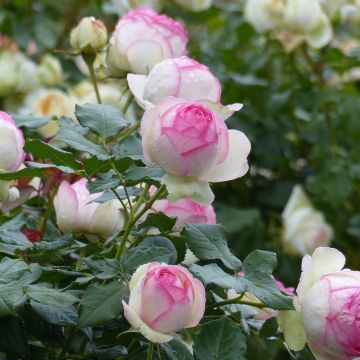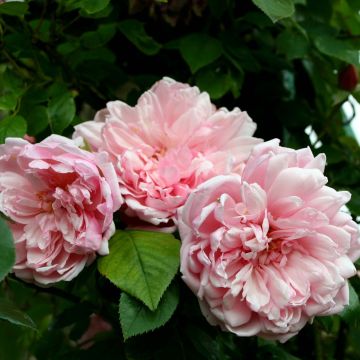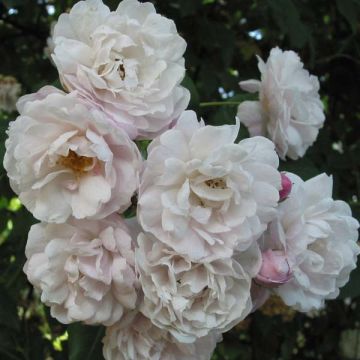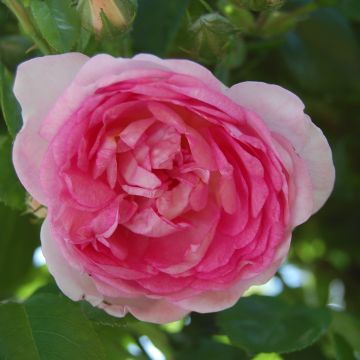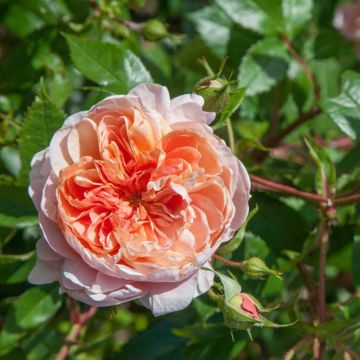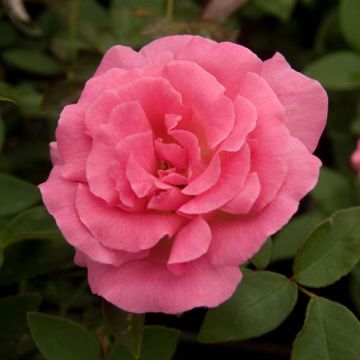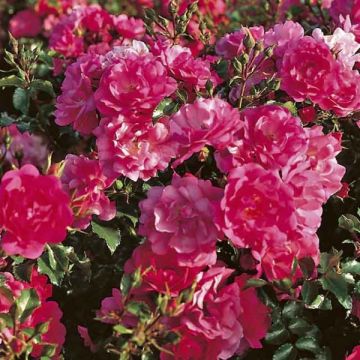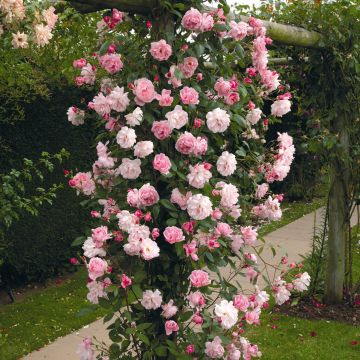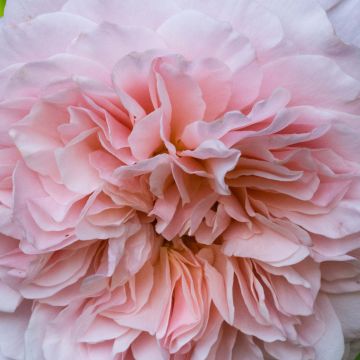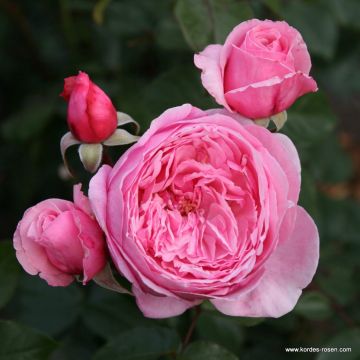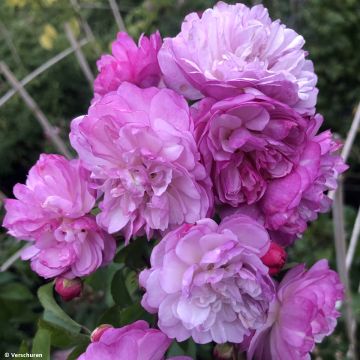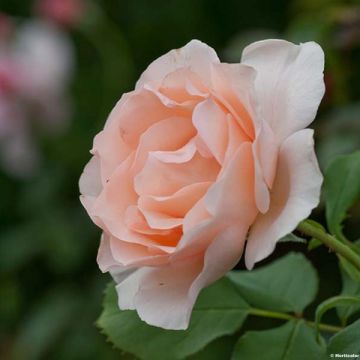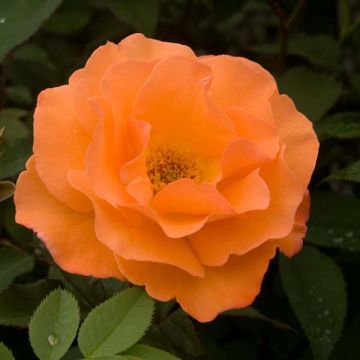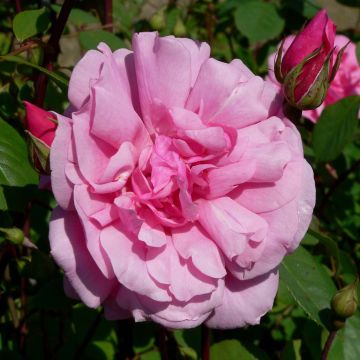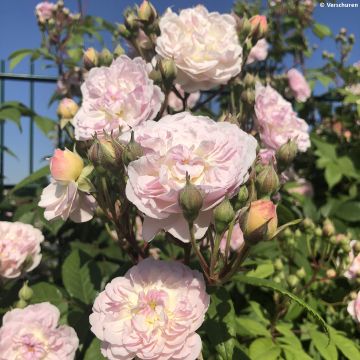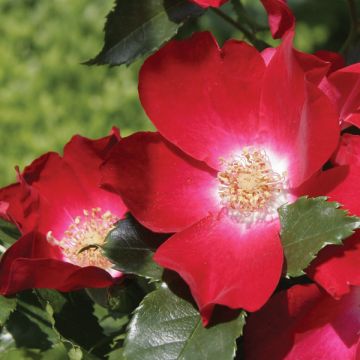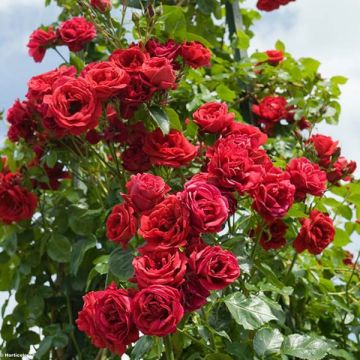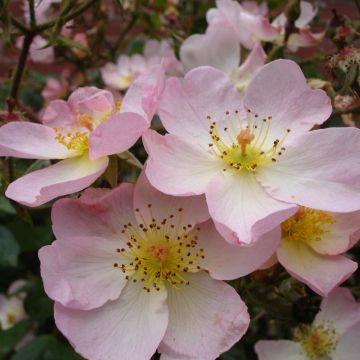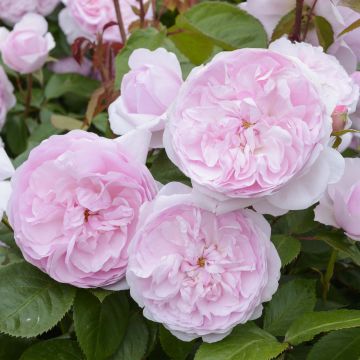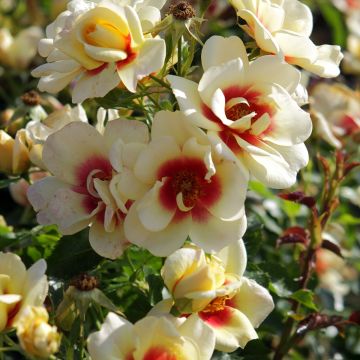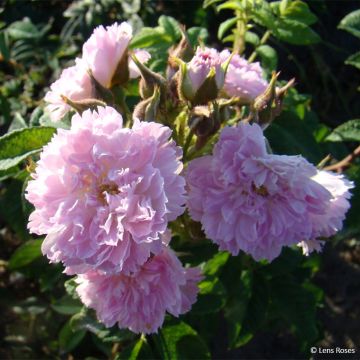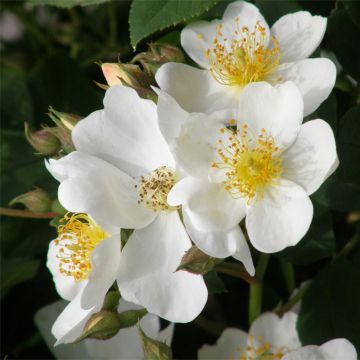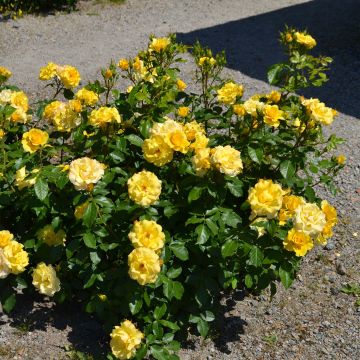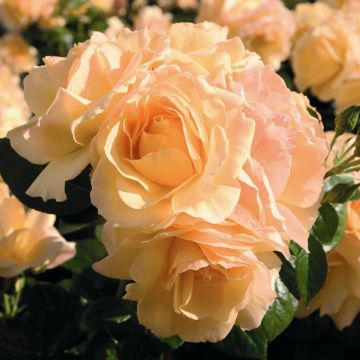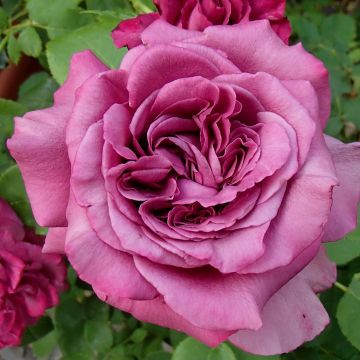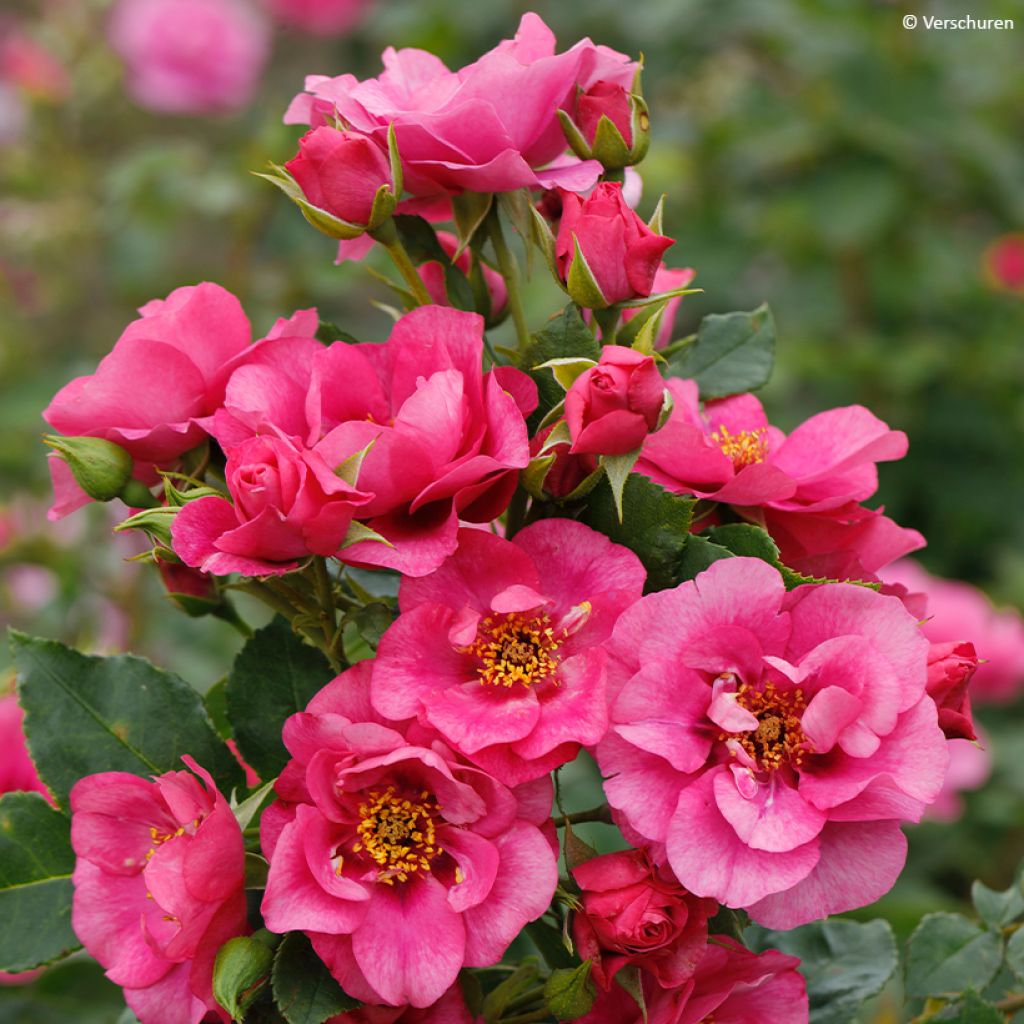

Rosa Orienta 'Aladdin'
Rosa Orienta 'Aladdin'
Rosa Orienta® Aladdin
Why not try an alternative variety in stock?
View all →This plant carries a 6 months recovery warranty
More information
We guarantee the quality of our plants for a full growing cycle, and will replace at our expense any plant that fails to recover under normal climatic and planting conditions.
From €5.90 for pickup delivery and €6.90 for home delivery
Express home delivery from €8.90.
From €5.90 for pickup delivery and €6.90 for home delivery
Express home delivery from €8.90.
Delivery to Corse prohibited: UE law prohibits the import of this plant from mainland France to Corse as part of the fight against Xylella fastidiosa. Please accept our sincere apologies.
More information
Does this plant fit my garden?
Set up your Plantfit profile →
Description
The Orienta 'Aladdin' rose is a recent German variety that embodies the charm of old-fashioned roses. Its pretty semi-double flowers reveal a heart of golden stamens that delight bees. With a vibrant pink colour leaning towards fuchsia, creating a happy contrast with the centre, these roses have a pleasant fragrance. This rose blooms from June to October in successive waves on healthy dark green foliage. Resistant to diseases and hardy, this medium-sized climber will find its place in all gardens, beautifully dressing up a pergola or trellis.
Introduced to the market in 2020, 'Aladdin' is the first rose of the Orienta collection developed by the German company Tantau. Rosenwelt Tantau ("the world of Tantau roses") is a leading rose breeder in Germany. As a recent variety, it benefits from advances in horticultural research by showing good resistance to black spot disease, mildew, and powdery mildew (rated 3/4 for these three diseases that can cause leaf markings and even leaf drop in severe cases).
This is a medium-sized climber that, when trained on a support, will reach a height of 2 to 3 m (7 to 10ft) with a width of 1 to 1.50 m (3 to 5ft). It is well suited for small gardens and ideal for adorning a trellis along a wall or covering a pergola or arbour. The foliage is dark green with a glossy surface, providing a dark background that highlights the brightly coloured roses. These appear in May, grouped in corymbs (bouquets) of 5 to 10 flowers or more. The roses are semi-double, with two or three rows of petals forming an open cup, allowing the stamens in the centre to be visible. They measure 6 to 8 cm (2 to 3in) in diameter and stand out against the foliage. With an intense pink colour bordering on fuchsia, the petals contrast with the golden centre of the corolla. This open flower morphology, combined with the amount of pollen produced, has an attractive effect on bees and other pollinating insects. This rose is, therefore, an ally for garden biodiversity, promoting the development of wildlife. Very floriferous, it produces successive waves of roses from June to October, especially if faded flowers are removed to encourage the growth of new flower buds. Emitting a light but delightful fragrance, this climber is an excellent choice for the garden.
'Aladdin' is an excellent choice for adorning a trellis, pergola, or arch. As a medium-sized climber, training and maintaining through annual pruning is easy. Create a stunning scene by planting a 'Pistachio' Clematis alongside its large white flowers measuring 10 cm (4in) in diameter. Starting before the rose, the April-May flowering will provide you with a beautiful display and accompany the clematis's second flowering in October. You can also create a beautiful colour combination with the 'Goldfassade' rose, with its very bright yellow flowers that will contrast beautifully with those of 'Aladdin'. Play with foliage by pairing this rose with Golden Tassels hops, which have highly golden cut leaves that will stand out next to the dark green of the rose and its pink flowers.
Report an error about the product description
Rosa Orienta 'Aladdin' in pictures
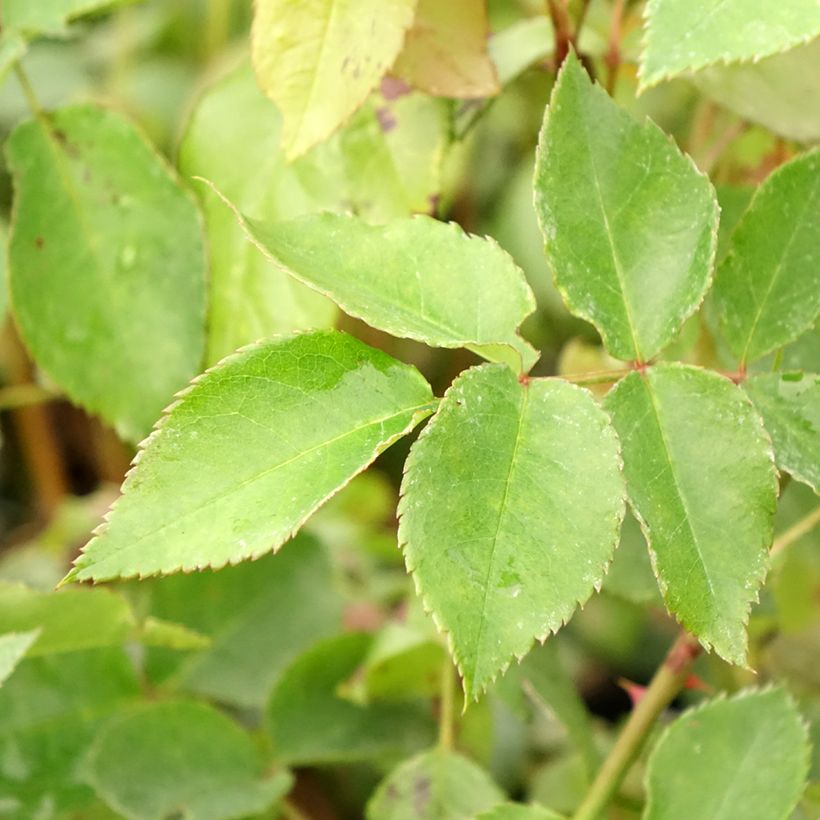

Plant habit
Flowering
Foliage
Botanical data
Rosa
Orienta® Aladdin
Rosaceae
Cultivar or hybrid
Other Climbing Roses
Planting and care
The Orienta 'Aladdin' climbing rose prefers sunny locations with more intense flowering. To plant your rose, work the soil by crumbling it well and put organic amendment, such as compost, or organic fertiliser, such as blood, fish and bone, at the bottom of the planting hole. Soak the root ball in a bucket of water for fifteen minutes before planting, then position the rose in the planting hole, fill in around it, and water abundantly. Then, make regular water contributions during the first year and gradually space them out to force the roots to descend into the soil.
Spring pruning consists of removing a portion of the old branches at the base each year, thus keeping a framework while rejuvenating your rose. Prune the branches of the year to 3 or 4 buds. Regularly remove faded flowers during the summer to stimulate the development of younger buds. Training a few main branches horizontally during pruning allows for a more abundant flowering. In spring, you can mound soil around the base of the branches to protect the graft point from the sun and wind.
Roses are often stained or unsightly in late summer, but their development is not a problem. These stains are not harmful to the rose but are natural.
Planting period
Intended location
Care
-
, onOrder confirmed
Reply from on Promesse de fleurs
Roses by purpose
Haven't found what you were looking for?
Hardiness is the lowest winter temperature a plant can endure without suffering serious damage or even dying. However, hardiness is affected by location (a sheltered area, such as a patio), protection (winter cover) and soil type (hardiness is improved by well-drained soil).

Photo Sharing Terms & Conditions
In order to encourage gardeners to interact and share their experiences, Promesse de fleurs offers various media enabling content to be uploaded onto its Site - in particular via the ‘Photo sharing’ module.
The User agrees to refrain from:
- Posting any content that is illegal, prejudicial, insulting, racist, inciteful to hatred, revisionist, contrary to public decency, that infringes on privacy or on the privacy rights of third parties, in particular the publicity rights of persons and goods, intellectual property rights, or the right to privacy.
- Submitting content on behalf of a third party;
- Impersonate the identity of a third party and/or publish any personal information about a third party;
In general, the User undertakes to refrain from any unethical behaviour.
All Content (in particular text, comments, files, images, photos, videos, creative works, etc.), which may be subject to property or intellectual property rights, image or other private rights, shall remain the property of the User, subject to the limited rights granted by the terms of the licence granted by Promesse de fleurs as stated below. Users are at liberty to publish or not to publish such Content on the Site, notably via the ‘Photo Sharing’ facility, and accept that this Content shall be made public and freely accessible, notably on the Internet.
Users further acknowledge, undertake to have ,and guarantee that they hold all necessary rights and permissions to publish such material on the Site, in particular with regard to the legislation in force pertaining to any privacy, property, intellectual property, image, or contractual rights, or rights of any other nature. By publishing such Content on the Site, Users acknowledge accepting full liability as publishers of the Content within the meaning of the law, and grant Promesse de fleurs, free of charge, an inclusive, worldwide licence for the said Content for the entire duration of its publication, including all reproduction, representation, up/downloading, displaying, performing, transmission, and storage rights.
Users also grant permission for their name to be linked to the Content and accept that this link may not always be made available.
By engaging in posting material, Users consent to their Content becoming automatically accessible on the Internet, in particular on other sites and/or blogs and/or web pages of the Promesse de fleurs site, including in particular social pages and the Promesse de fleurs catalogue.
Users may secure the removal of entrusted content free of charge by issuing a simple request via our contact form.
The flowering period indicated on our website applies to countries and regions located in USDA zone 8 (France, the United Kingdom, Ireland, the Netherlands, etc.)
It will vary according to where you live:
- In zones 9 to 10 (Italy, Spain, Greece, etc.), flowering will occur about 2 to 4 weeks earlier.
- In zones 6 to 7 (Germany, Poland, Slovenia, and lower mountainous regions), flowering will be delayed by 2 to 3 weeks.
- In zone 5 (Central Europe, Scandinavia), blooming will be delayed by 3 to 5 weeks.
In temperate climates, pruning of spring-flowering shrubs (forsythia, spireas, etc.) should be done just after flowering.
Pruning of summer-flowering shrubs (Indian Lilac, Perovskia, etc.) can be done in winter or spring.
In cold regions as well as with frost-sensitive plants, avoid pruning too early when severe frosts may still occur.
The planting period indicated on our website applies to countries and regions located in USDA zone 8 (France, United Kingdom, Ireland, Netherlands).
It will vary according to where you live:
- In Mediterranean zones (Marseille, Madrid, Milan, etc.), autumn and winter are the best planting periods.
- In continental zones (Strasbourg, Munich, Vienna, etc.), delay planting by 2 to 3 weeks in spring and bring it forward by 2 to 4 weeks in autumn.
- In mountainous regions (the Alps, Pyrenees, Carpathians, etc.), it is best to plant in late spring (May-June) or late summer (August-September).
The harvesting period indicated on our website applies to countries and regions in USDA zone 8 (France, England, Ireland, the Netherlands).
In colder areas (Scandinavia, Poland, Austria...) fruit and vegetable harvests are likely to be delayed by 3-4 weeks.
In warmer areas (Italy, Spain, Greece, etc.), harvesting will probably take place earlier, depending on weather conditions.
The sowing periods indicated on our website apply to countries and regions within USDA Zone 8 (France, UK, Ireland, Netherlands).
In colder areas (Scandinavia, Poland, Austria...), delay any outdoor sowing by 3-4 weeks, or sow under glass.
In warmer climes (Italy, Spain, Greece, etc.), bring outdoor sowing forward by a few weeks.

































